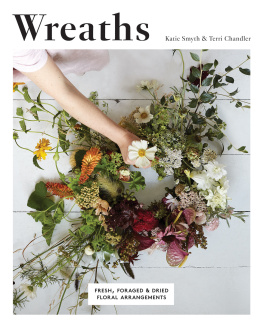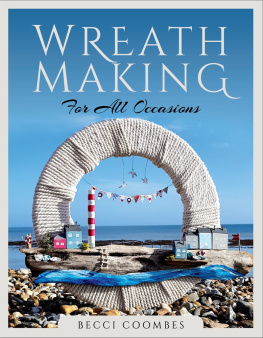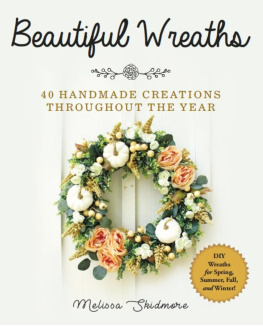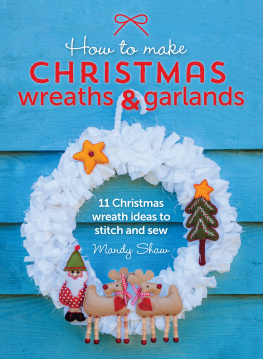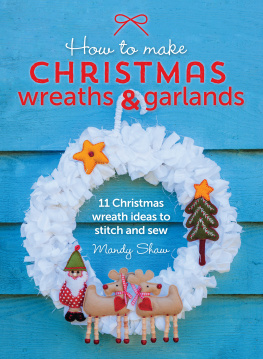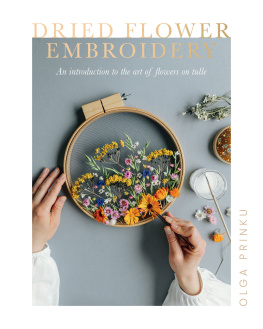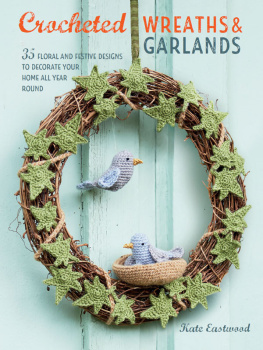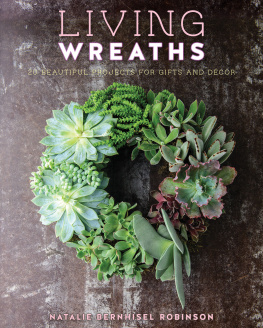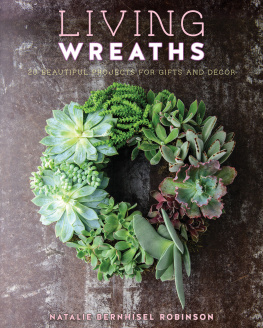To Paddy and Mike, long may your patience last x
Publishing Director Sarah Lavelle
Editor Harriet Butt
Creative Director Helen Lewis
Design and Art Direction Gemma Hayden
Photographer Kristin Perers
Prop Stylist Linda Berlin
Styling Katie Smyth & Terri Chandler
Production Director Vincent Smith
Production Controller Jessica Otway
Published in 2018 by Quadrille, an imprint of Hardie Grant Publishing
Quadrille
5254 Southwark Street
London SE1 1UN
quadrille.com
All rights reserved. No part of this publication may be reproduced, stored in a retrieval system or transmitted in any form by any means, electronic, mechanical, photocopying, recording or otherwise, without the prior written permission of the publishers and copyright holders.
The moral rights of the authors have been asserted.
Text Katie Smyth & Terri Chandler 2018
Photography Kristin Perers 2018
Design Quadrille Publishing 2018
eISBN 978 178713 280 1
Contents
CREATE SOME THING FROM A FEW SIMPLE STEPS
Crafts using natural materials are having a bit of a moment. For the first time in years, it feels like people are foraging again for food and plant life to bring indoors. Nurturing that connection with the world around us and its changing seasons is important to us, and we want to encourage you to experience this too. Challenging yourself to make something out of a few stems you gathered while out for a walk, or from your garden, brings such satisfaction and a little bit of natures beauty into your home.
Taking time out to create something for yourself is the most rewarding feeling. So rewarding that we have made it our lives! We were stuck in jobs that were making us feel a little bit sad, especially when setting the alarm every evening. Now when the alarm goes off (usually about 4am) we are giddy to get going (okay the giddiness might come a few hours later). Being around nature really does make you feel wonderful.
Over the last few years we have been lucky enough to travel for work and one of the things that we kept spotting in countries around the world were wreaths. They come in all sizes and materials, and they are used to mark a wide range of occasions, and with many different meanings. We have seen garlic-donned wreaths above the doorways of homes on Greek islands to welcome in the first day of May, wildflower wreaths in Scandinavia to signal midsummer, and in America the whole nation is speckled with flamboyant door wreaths to celebrate Thanksgiving.
A wreath can be a wonderful gift, a warm welcome or a beautiful wall decoration. There are so many ways that wreaths, along with wall hangings, can be incorporated into your home.
Making something with meaning has always been really important to us. This is why we love the language of flowers and are always trying to convey a subtle message through everything we create. When we make a wreath for a wedding, for example, we always fill it with flowers that symbolise everlasting love. You may like to take a similar approach with some of your wreaths, especially those for special occasions. You can find lots of information about the language of flowers on the Internet.
We love the thought of people going out to forage and making their very own beautiful creations which will be all so different depending on what part of the world they are from. We would be so happy to see some of your own creations!
Terri and Katie. Worm x
THERE ARE NO RULES
All the projects in this book are relatively straightforward. Have a look at the picture of each one; if it looks simple to make, then it probably is. Those that are bigger and appear more complicated may take longer to make and need more materials, but nothing in this book is very difficult when you are equipped with the right skills and techniques.
Please use our directions simply as guidelines. What we love most about these kinds of projects is that they are instinctive and natural; they will look completely different depending on the materials used and the creativity of the person making them.
When we host workshops, we often do a quick demonstration first so that our clients understand the making process. We then leave them to their own devices, and that is when we really see their personalities shine through. Some are neat and intricate, others brilliantly chaotic and wild. So try to go with what comes naturally to you and not just what you see in the picture.
We have tried to make the methods and materials in this book as accessible as possible. Some are not necessarily those used in traditional floristry, but this is how we make all of these projects ourselves. They also show how you can use shapes and materials that you may already have in your own home or garden to make something really personal and beautiful. Trust your instincts: if you are inspired to use a different material or method then go with it. There are no hard and fast rules to wreath making.
In the following section, we have included instructions on how to make a basic wreath using plant vine. Once you have mastered this, then you already have the beginning of many of the projects in the book. We also explain how to prepare floral foam, and give guidelines on using floristry wires.
We have tried, where possible, to include measurements and quantities in the projects, but again these are only guidelines. We encourage you to trust your own taste and judgement when collecting plant materials for a wreath and the amount to gather, and have confidence in your vision of how you would like your finished piece to look.
Many of the materials you need for making wreaths can be found in floristry supplies retailers, craft or hardware shops; most of the others you will find in nature.
FROM TOP TO BOTTOM:
CALICO
We use calico or Irish linen to make hangers for many of our wreaths and mobiles. You can buy them by the metre/yard from your local haberdashery and cut them into strips. Calico is the cheaper of the two, but Irish linen is lovely to handle and comes in lots of beautiful shades.
DRESSMAKING SCISSORS
We have learned how important it is to use the correct scissors for the task at hand. Florists scissors will ruin fabric, so dressmaking scissors are a must if you are cutting cloth.
CLEAR THREAD
Available from most craft or hardware shops, this comes in different thicknesses. It is good to have a really fine thread along with a thicker, stronger one that can take a bit of weight.
FLORISTS SCISSORS
These are strong enough to cut woody stems as well as soft stems. Try to keep them dry so that they dont start to rust and become stiff.

